A resilient and robust foundation is a sure way to guarantee a stable structure that could withstand and tolerate the forces of nature by satisfying the strength and serviceability requirements. Primarily the significance of foundation in a structure is same as the importance of the word “foundation”. Failure of foundation is a predominant reason behind the instability of the entire structure.
Underpinning can be defined as a technique that is followed to either deepen already built foundation or to repair a faulty and damaged foundation.
The extension of depth in foundation is indispensable if there is a plan to increase the number of floors of a building. Visible cracks observed in the building are a symptom of necessity of foundation correction which can be done by underpinning.
Generally, if the cracks observed in the buildings are greater than one-fourth of an inch then the need for underpinning of the foundation is a must. The problems of heaved foundations, buckled wall, concrete walls with cracks can be regarded as foundation failures.
As per the underpinning method, the damaged foundation is supported with the help of permanent or temporary support. This arrangement will help in increasing the bearing capacity as well as additional extension of the depth.
Structural Requirements That Make Underpinning a MUST
There are certain failure conditions of foundation that will make the engineer to come up with the decision of underpinning.
The answer to the question that When to use the underpinning method for foundation repair? is answered below:
- Most of the normal buildings have foundations that are made from timber. These after a time period will undergo settlement. These settlement of the foundation is due to the degradation of the timber which is caused by the water table fluctuations.
- The bearing capacity of the soil is decreased with the rising and the lowering of
- the water table. This will result in the settlement of the structure.
- Construction of structure over a soil with lesser bearing capacity too result in the settlement of the structure.
Repair of Foundation by Underpinning
The distress observed in the foundation may be due to settlement as mentioned or due to the movement of the slope or due to the expansive soils present underneath. The main requirement of foundation repair is,
Like Us on Facebook!
Subscribe Us on YouTube!
- Either to stabilize the foundation in the present condition so that no further distress is welcomed.
- Or to lift and restore the foundation to a particular elevation as required
Diagnosis for foundation repair by Underpinning
There are certain steps to be determined initially to understand the risk of the foundation. These include:
1. Surface Exploration so that cause of distress is determined
2. The foundation risk and the potential repair is enlisted
3. The above risk is discussed with the owner and develop a decision for underpinning.
4. The need for partial or fully underpinning is made
Methods of Underpinning Foundation
There are different methods which can be followed to undergo underpinning procedures which are explained in detailed below.
- Mass Concrete Method or Pit Method
- Pier and Beam Underpinning Method
- Underpinning by Cantilever Method
- Pile Method of Underpinning
- Pre-test Method of Underpinning
- Mini Piled Underpinning
Even if there are different method of underpinning for the repair of foundation, all the methods follow same concept of extending the foundation.
The extension made can be either in lengthwise or breadth-wise. This is done over a soil which is strong, hence equal distribution of the load is taken place.
Mass Concrete Method of Underpinning
This method is also called as pit method and is a traditional method of underpinning. The method will carry out the procedure of extension of the foundation till it reaches a hard stratum. For this, the soil below the existing foundation is removed and excavated. The removal is carried out in stages so that sudden collapse of soil is not occurred. Once the stratum is approached it is filled with concrete and allowed for curing afterwards. Only after completion of one stage, next excavation is started.
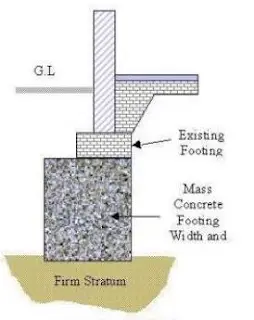 |
| Fig-1 Pit Method of Underpinning |
The existing foundation has to transfer safely load to the new foundation i.e the mass concrete footing as shown in figure-1 above. For this, a pin is provided in between them by placing a pack of dry sand-cement.
This method of underpinning is performed for a shallow depth. The method have an advantage that no kind of machinery is necessary for the excavation process. The new
mass concrete structure constructed will behave as a barrier and protect the old foundation.
Cantilever Needle Beam Method of Underpinning
This method is an extension of above-described pit method and is often named as Cantilever pit method of underpinning. This method is suitable if the building has a strong interior column and that the deepening of foundation can be done only in one direction due to site limitations.
In this method an underpinning pit is excavated beneath the existing exterior wall whose foundation is faulty. A needle beam is strapped to join the exterior wall with that of existing interior loaded column or pedestal. The exterior wall is hanged with the needle beam arrangement pushed up by a hydraulic jack supported on Fulcrum.
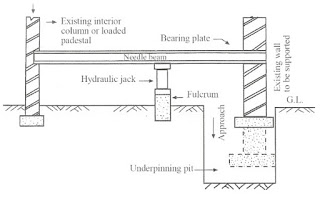 |
| Fig-2 Extended Pit Method of Underpinning |
This method is faster than the traditional method. With this procedure being adopted the load carrying capacity of foundation is increased.
Another slight modification of this method also exists in which the existing foundation is supported by a Cantilever beam strapped to tension piles and compression piles which were rested on firm strata underneath as shown in the figure below.
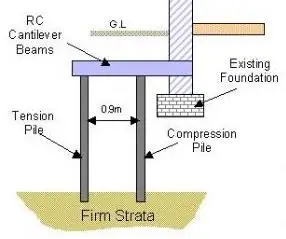 |
| Fig-3 Cantilever Needle Beam Method of Underpinning-Sectional View |
Pier and Beam Method of Underpinning
This method is developed to cover the limitation of mass concreting method. This method is good for relatively deeper foundation and is feasible for all the soil conditions. In this method reinforced concrete beams are placed supported on the mass concrete underneath the ground or piers as shown in figure-3.
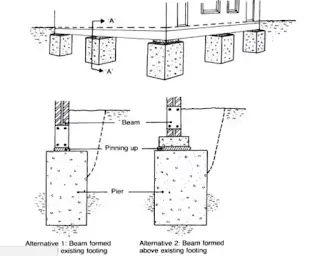 |
| Fig-4 Pier and Beam Method |
The ground conditions and the extent of load to be carried will decide the size and the dimensions of the piles. For foundation that is deeper than 6m, this method is economical.
Mini Piled Method of Underpinning
For cases where the load is to be transferred to a stratum that is situated at a depth greater than 5m can make use of mini piles of diameter 150 to 300m. Areas, where the soil nature is highly variable and is a restricted area for access, can make use of this method. These piles can be either driven steel or augured types. The maximum depth possible is 15m.
Here as shown in the figure-4 piles are driven on either sides of a weak foundation. The piles driven are connected to the existing weak foundation through needles. These needles hence act like a pile cap.
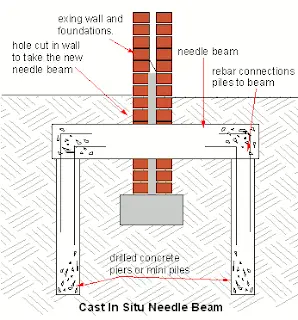 |
| Fig-5 – Pile Method of Underpinning |
The settlement issues that are caused due to water clogging or the clay nature of the soil can be corrected by this method.
As shown in the figure-4 a hole is made in the existing wall to facilitate the needle beam.
Pre-test Method of Underpinning
This method is suitable for buildings with 5 to 10 stories and the foundation type of pad and strip footing. The method will involve the initial compaction as well as compression of the underneath soil after excavation. Thus, soil is subjected to predetermined loads. All these procedures are done before underpinning. Raft foundation can also use this method. The pre-test method has less noise and disruption during construction.
Whats Next?
If your house is having a foundation that is still not solved by underpinning than you must opt for Pile foundation and We have written a detailed article about it so why not go to that.









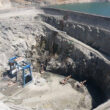


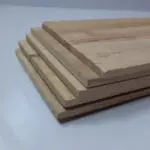


This comment has been removed by a blog administrator.
This comment has been removed by a blog administrator.